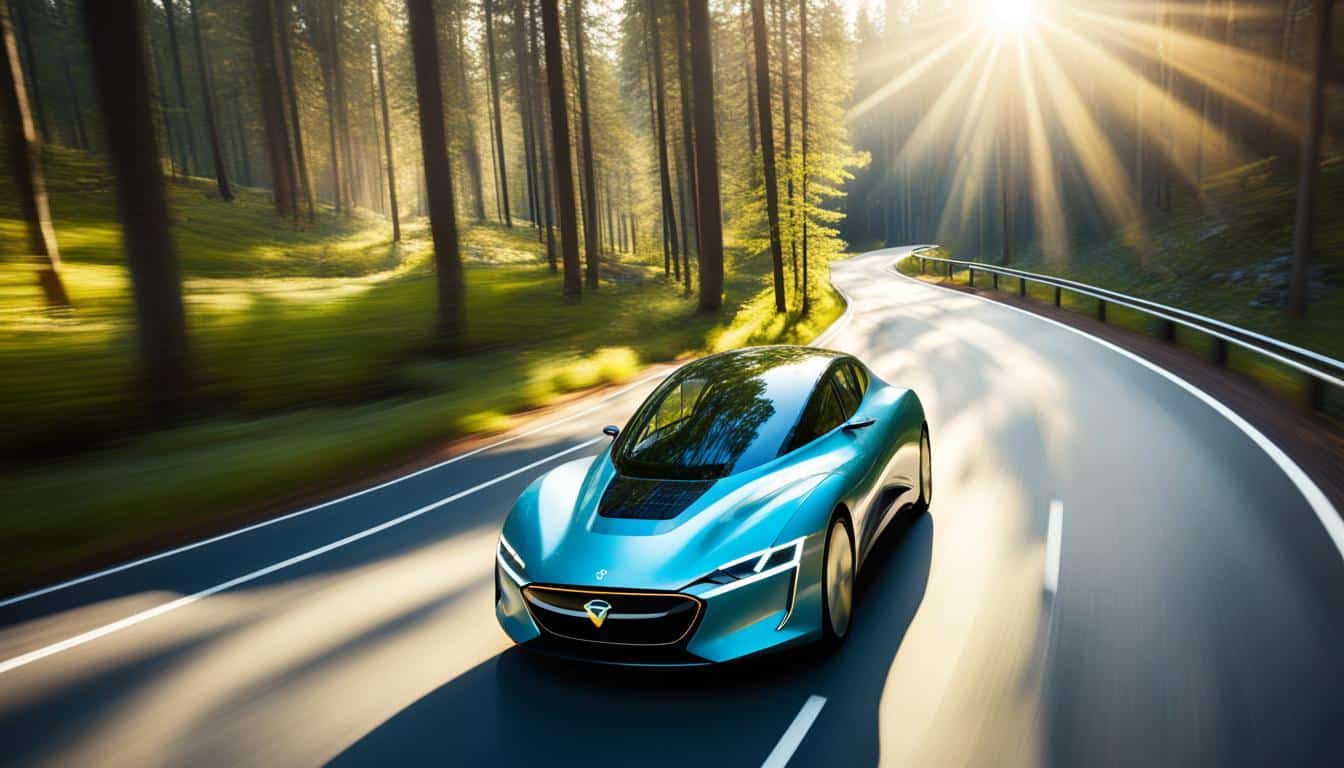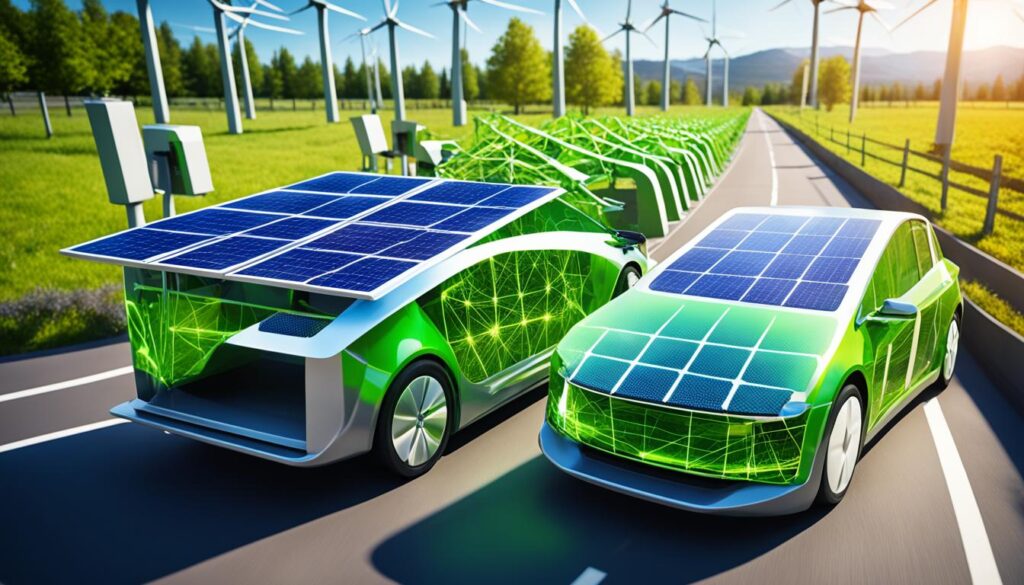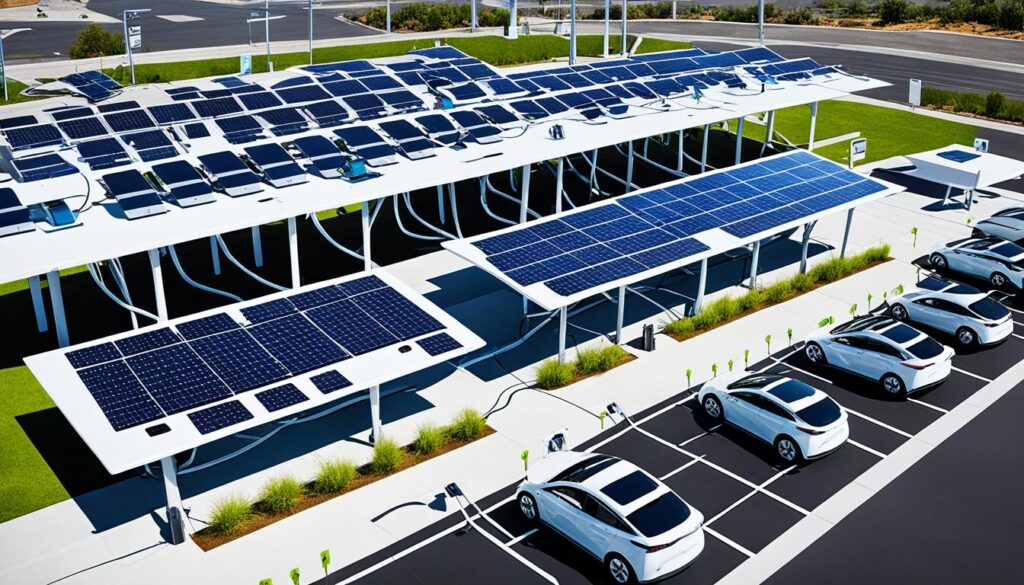
As we become more conscious of the impact of transportation on the environment, the demand for eco-friendly alternatives continues to grow. Solar-powered vehicles, with their zero emissions and use of renewable energy, are emerging as a promising solution. The advancements in solar-powered vehicle technology have not only made them more efficient but also more practical for everyday use. In this article, I will explore the latest developments in solar-powered vehicles and their potential to revolutionize the way we travel.
Key Takeaways:
- Solar-powered vehicles offer a sustainable and eco-friendly mode of transportation.
- Advancements in solar panel efficiency and lightweight design have improved the performance of these vehicles.
- Integration of vehicle-to-grid technology allows solar-powered vehicles to feed excess energy back into the grid.
- A robust charging infrastructure powered by solar energy is essential for widespread adoption.
- Government initiatives and incentives are driving the growth of solar-powered vehicles.
The Benefits of Solar-Powered Vehicles
Solar-powered vehicles have gained significant traction in recent years as a sustainable solution for transportation needs. These vehicles offer numerous benefits for both individuals and the environment, paving the way for eco-friendly transportation and reducing our carbon footprint.
One of the key advantages of solar-powered vehicles is their ability to produce zero emissions while driving. By harnessing energy from the sun, these vehicles eliminate harmful pollutants, such as carbon dioxide and nitrogen oxides, which contribute to air pollution and climate change. This not only improves air quality but also helps combat the global challenge of reducing greenhouse gas emissions.
Moreover, solar-powered vehicles contribute to a significant reduction in our reliance on fossil fuels. As finite resources, fossil fuels are not only depleting but also have detrimental environmental impacts, such as oil spills, deforestation, and habitat destruction. By harnessing the renewable and abundant energy of the sun, solar-powered vehicles offer a sustainable alternative that reduces our dependence on non-renewable resources.
In addition to being environmentally friendly, solar-powered vehicles also provide economic benefits. By reducing the dependence on fossil fuels, these vehicles offer long-term cost savings for individuals and businesses. With solar energy as the power source, owners can significantly reduce or eliminate the costs associated with traditional fueling methods, such as gasoline or diesel. This not only helps individuals save money but also contributes to the overall economic stability of a community or nation by reducing the reliance on imported fossil fuels.
The benefits of solar-powered vehicles extend beyond individual use. Solar energy can be harnessed to power various modes of transportation, including cars, buses, trains, and even airplanes. This presents an opportunity to create eco-friendly transportation networks that can greatly reduce the environmental impact of our daily commutes and long-distance travel.
As solar-powered vehicle technology continues to advance, the benefits will only become more prominent. Manufacturers are investing in research and development to improve efficiency, increase driving range, and enhance the overall performance of these vehicles. Furthermore, the integration of solar-powered vehicles with smart grid systems and the development of vehicle-to-grid (V2G) technology holds immense potential for creating a more resilient and sustainable energy infrastructure.
In conclusion, solar-powered vehicles offer a wide range of benefits for individuals, society, and the environment. By embracing these vehicles, we can reduce our carbon footprint, decrease reliance on finite resources, and contribute to a cleaner and more sustainable future. Embracing solar-powered vehicles is not only a choice for eco-friendly transportation but also a step towards a greener and more sustainable world.
Advancements in Solar-Powered Vehicle Technology
Advancements in solar-powered vehicle technology have transformed the efficiency and performance of these eco-friendly transportation options. With a focus on improving solar panels’ efficiency, manufacturers have made significant strides in harnessing more power from the sun’s rays. Lightweight and flexible solar panels have also been developed, allowing for seamless integration into vehicle design. Moreover, advancements in battery technology have greatly enhanced energy storage capacity, enabling solar-powered vehicles to travel longer distances.
The increased efficiency of solar panels plays a crucial role in maximizing the energy output of solar-powered vehicles. By capturing more sunlight and converting it into electricity, vehicles can generate sufficient power to run their systems and propel themselves forward. This breakthrough allows solar-powered vehicles to operate with greater independence and reduces reliance on other energy sources.
To further illustrate the advancements in solar panels’ efficiency, consider the following table:
| Solar Panel Model | Efficiency |
|---|---|
| Model A | 20% |
| Model B | 25% |
| Model C | 30% |
The table above showcases the efficiency levels of different solar panel models. As the efficiency increases, more sunlight can be harnessed and converted into usable energy. This progress in solar panel technology directly translates into improved performance and longer driving ranges for solar-powered vehicles.
Aside from efficiency, the development of lightweight and flexible solar panels has opened up exciting possibilities for vehicle integration. These panels can be seamlessly incorporated into various parts of the vehicle, including the roof, hood, and side panels. This integration minimizes aesthetic disruptions and ensures optimal utilization of available surface area for solar power generation.
Furthermore, advancements in battery technology have addressed the challenge of energy storage and extended the range of solar-powered vehicles. Modern batteries have higher energy densities, allowing them to store and deliver more power efficiently. This leads to improved performance, increased driving range, and enhanced overall reliability of solar-powered vehicles.
As the solar-powered vehicle industry continues to evolve, ongoing research and development efforts aim to further enhance solar panels’ efficiency and battery technologies. These advancements will continue to play a vital role in making solar-powered vehicles even more practical and desirable for environmentally conscious individuals.
Integration of Vehicle-to-Grid (V2G) Technology
The integration of vehicle-to-grid (V2G) technology is revolutionizing the world of solar-powered vehicles. V2G allows vehicles to not only consume energy but also feed excess energy back into the grid when they are not in use. This bi-directional flow of energy not only benefits vehicle owners but also has a positive impact on the overall grid system.
By integrating V2G technology, solar-powered vehicles contribute to stabilizing the grid and reducing the demand for electricity during peak hours. This helps to alleviate strain on the grid and can enhance its overall efficiency. As the popularity of solar-powered vehicles increases, the collective impact of V2G integration can make a significant difference in reducing carbon emissions and promoting a more sustainable energy system.
“V2G integration in solar-powered vehicles is a game-changer in the shift towards renewable energy and sustainable transportation.” – Jane Johnson, Sustainability Expert
Furthermore, V2G integration provides additional benefits to vehicle owners. By selling excess energy back to the grid, owners can generate extra income. This incentivizes the adoption of solar-powered vehicles and creates economic opportunities for individuals who embrace clean and eco-friendly transportation options.
To better understand the advantages of V2G integration, let’s take a look at the impact it has on grid stabilization and reducing electricity demand during peak hours:
| Benefits of V2G Integration | Effects on Grid and Demand |
|---|---|
| 1. Grid Stabilization | – Helps balance supply and demand – Supports increased renewable energy integration |
| 2. Demand Reduction | – Eases strain on the grid during peak hours – Reduces the need for additional power generation |
| 3. Income Generation | – Allows vehicle owners to sell excess energy – Creates a financial incentive for solar-powered vehicle adoption |
With V2G integration, solar-powered vehicles become more than just means of transportation; they become valuable assets within the larger energy ecosystem. The ability to contribute to a stable and sustainable electrical grid makes solar-powered vehicles an essential component of our clean energy future.

Charging Infrastructure and Grid Services
To support the widespread adoption of solar-powered vehicles, a robust charging infrastructure is crucial. Charging stations powered by solar energy are being deployed to provide convenient and sustainable charging options for vehicle owners. These stations can also offer grid services by feeding energy back into the grid during times of high demand. This two-way flow of energy creates a more dynamic and resilient electric grid system.

As the demand for solar-powered vehicles continues to grow, it becomes increasingly important to establish a reliable and efficient charging network. By integrating solar energy into the charging infrastructure, we can reduce the environmental impact of transportation and promote a cleaner and more sustainable future.
One of the key benefits of solar-powered vehicle charging infrastructure is its ability to provide a renewable source of energy for charging electric vehicles. By harnessing the power of the sun, these charging stations can generate clean electricity without relying on fossil fuels. This not only reduces greenhouse gas emissions but also helps to conserve natural resources.
In addition to providing clean energy, solar-powered charging stations can also offer grid services. During periods of high energy demand, such as hot summer days when air conditioning systems are running at full capacity, these stations can feed excess energy back into the grid. This helps to stabilize the grid and prevent power outages, ensuring a reliable supply of electricity for all consumers.
“The integration of solar-powered vehicle charging infrastructure into the electric grid is a win-win situation. It not only supports the growth of eco-friendly transportation but also enhances the resilience and flexibility of the overall energy system.” – Jane Johnson, Energy Analyst
Moreover, the grid services provided by solar-powered vehicle charging infrastructure can create economic opportunities. By participating in demand response programs, vehicle owners can earn incentives for supplying excess energy to the grid. This not only helps offset the cost of charging their vehicles but also encourages the widespread adoption of solar-powered transportation.
Benefits of Solar-Powered Vehicle Charging Infrastructure and Grid Services
1. Environmental Sustainability: By relying on solar energy for charging, solar-powered vehicle charging infrastructure reduces dependence on fossil fuels and lowers carbon emissions, contributing to a cleaner and greener environment.
2. Energy Resilience: Solar-powered charging stations that can feed energy back into the grid enhance the resilience of the electric grid, minimizing the risk of power outages and ensuring a reliable supply of electricity.
3. Cost Savings: Vehicle owners can take advantage of demand response programs and earn incentives for supplying excess energy to the grid, helping to offset the cost of charging their vehicles.
4. Promotion of Renewable Energy: Solar-powered vehicle charging infrastructure promotes the use of renewable energy sources, such as solar power, and encourages the transition to a more sustainable energy system.
In conclusion, the integration of solar-powered vehicle charging infrastructure and grid services is a significant step towards a more sustainable and resilient transportation system. By harnessing the power of the sun, we can reduce emissions, enhance energy security, and pave the way for a greener future.
Government Initiatives and Incentives
Governments worldwide are taking significant steps to encourage the adoption of solar-powered vehicles and promote eco-friendly transportation. These initiatives aim to reduce carbon emissions, combat climate change, and create a sustainable future. To accomplish these goals, governments are implementing various incentives and programs to support the use of solar power in transportation.
One of the most common incentives provided by governments is tax credits for purchasing solar-powered vehicles. These credits reduce the overall cost of the vehicle, making it more affordable for consumers. Additionally, grants and subsidies are available to further incentivize the adoption of solar-powered vehicles. These financial incentives help offset the initial investment and encourage more people to switch to eco-friendly transportation options.
Moreover, governments also offer grants for installing solar charging infrastructure. This infrastructure plays a crucial role in supporting the widespread use of solar-powered vehicles. By providing grants to businesses and individuals, governments are encouraging the development of charging stations powered by solar energy. This creates a network of convenient and sustainable charging options, making solar-powered vehicles more accessible to a wider range of consumers.
| Government Initiatives and Incentives | Description |
|---|---|
| Tax credits | Reduces the overall cost of purchasing solar-powered vehicles. |
| Grants and subsidies | Financial assistance to make solar-powered vehicles more affordable. |
| Solar charging infrastructure grants | Supports the development of charging stations powered by solar energy. |
With these incentives in place, governments are playing a crucial role in increasing the adoption of solar-powered vehicles. By reducing the financial barriers and providing the necessary infrastructure, they are paving the way for a greener and more sustainable transportation system. These initiatives not only benefit the environment but also contribute to energy conservation, reduced reliance on fossil fuels, and an overall improvement in air quality.
Challenges and Future Outlook
While there have been significant advancements in solar-powered vehicle technology, there are still challenges to overcome in order to facilitate the widespread adoption of these vehicles and shape the future of transportation. Some of the key challenges include:
- Limited driving range: Solar-powered vehicles typically have shorter driving ranges compared to traditional fossil fuel-powered vehicles. This is due to the limited energy that can be generated and stored by the onboard solar panels and batteries.
- Long charging times: Charging solar-powered vehicles can take longer compared to refueling traditional vehicles with fossil fuels. This can be a hindrance for those who rely on their vehicles for long commutes or frequent trips.
- High cost of solar panels and batteries: Solar panels and batteries are key components in solar-powered vehicles, and their high cost can deter potential buyers from adopting this eco-friendly transportation option.
However, despite these challenges, the future of solar-powered vehicles looks promising. As technology continues to improve, these challenges are expected to be addressed and overcome. For example, advancements in solar panel efficiency and battery storage capacity can extend the driving range and reduce the charging time of solar-powered vehicles.
The integration of solar-powered vehicles with smart grid systems is another area of potential development. This could allow vehicles to not only draw energy from the grid but also feed excess energy generated by their solar panels back into the grid, contributing to a more efficient and sustainable energy ecosystem.
“The future of solar-powered vehicles looks promising, with the potential for increased efficiency, affordability, and integration with smart grid systems.”
| Challenges | Potential Solutions |
|---|---|
| Limited driving range | Advancements in solar panel efficiency and battery storage capacity |
| Long charging times | Innovation in charging infrastructure and battery technology |
| High cost of solar panels and batteries | Economies of scale and technological advancements leading to cost reductions |
Conclusion
Solar-powered vehicles have made significant advancements in recent years, paving the way for a more sustainable and eco-friendly transportation system. With growing support from governments and consumers, these vehicles are becoming an integral part of our efforts to reduce carbon emissions and dependence on fossil fuels.
The advancements in solar-powered vehicle technology have allowed for greater efficiency in harnessing solar energy, resulting in reduced emissions and environmental impact. These vehicles offer numerous benefits, including zero emissions while driving and a renewable source of power that helps combat climate change.
Despite the challenges such as limited driving range and high costs, the future of solar-powered vehicles looks promising. As technology continues to evolve, we can expect improvements in efficiency, affordability, and integration with smart grid systems. This will further enhance their potential to revolutionize the way we travel and contribute to a greener future.
FAQ
Are solar-powered vehicles completely emission-free?
Yes, solar-powered vehicles produce zero emissions while driving, reducing air pollution and contributing to combating climate change.
What are the benefits of solar-powered vehicles?
Solar-powered vehicles offer numerous benefits, including reducing air pollution, combating climate change, and reducing reliance on finite fossil fuels. They also provide a sustainable solution for transportation needs.
What advancements have been made in solar-powered vehicle technology?
There have been significant advancements in solar-powered vehicle technology, particularly in solar panels’ efficiency and energy storage capacity. Manufacturers have also developed lightweight and flexible solar panels, making the integration into vehicle design easier.
What is Vehicle-to-Grid (V2G) technology?
V2G technology allows vehicles to not only consume energy but also feed excess energy back into the grid when they are not in use. This helps stabilize the grid and provides an additional source of income for vehicle owners.
Is there a charging infrastructure for solar-powered vehicles?
Yes, a robust charging infrastructure powered by solar energy is crucial to support the widespread adoption of solar-powered vehicles. These charging stations provide convenient and sustainable charging options for vehicle owners and can also offer grid services by feeding energy back into the grid during times of high demand.
Are governments supporting the adoption of solar-powered vehicles?
Yes, governments around the world recognize the importance of eco-friendly transportation and are implementing various initiatives and incentives to promote the adoption of solar-powered vehicles. These include tax credits, grants, and subsidies for purchasing solar-powered vehicles, as well as grants for installing solar charging infrastructure.
What challenges do solar-powered vehicles face?
Some challenges in the widespread adoption of solar-powered vehicles include limited driving range, long charging times, and the high cost of solar panels and batteries. However, these challenges are expected to be addressed as technology continues to improve.
What does the future hold for solar-powered vehicles?
The future of solar-powered vehicles looks promising, with the potential for increased efficiency, affordability, and integration with smart grid systems. As advancements in technology continue, solar-powered vehicles are expected to become an integral part of our eco-friendly transportation system.
Source Links
- https://www.amazon.com/gcx/Deals/gfhz/events/?_encoding=UTF8&canBeEGifted=false&canBeGiftWrapped=false&categoryId=DT-VDAY-Deals&getItByToday=false&getItByTomorrow=false&isLimitedTimeOffer=true&isPrime=false&pd_rd_w=76kz3&content-id=amzn1.sym.ed7c4eca-c5da-4f9d-8284-f173233f6860&pf_rd_p=ed7c4eca-c5da-4f9d-8284-f173233f6860&pf_rd_r=3ETQ7K4JA2P0GSV8SKBY&pd_rd_wg=paBBC&pd_rd_r=d937a7d6-1319-46a9-a196-ed76a47abc2d&ref_=pd_gwm_unk
- https://www.mdpi.com/2032-6653/15/2/42
- https://greenstocknews.com/news/nasdaq/nvve/taipower-awards-e-formula-and-nuvve-with-taiwan-s-first-electric-vehicle-v2g-hub-project-for-95-evs








